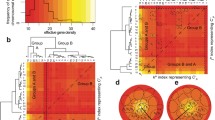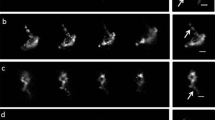Summary
Our working hypothesis is that the Q-darker human chromosome segments have higher gene densities than the bright regions. Especially prominent in this respect are six hot spots, the short Q-dark regions in 3p, 6p, 11q, 12q, 17q, and 19 (p or q), which have been chosen because their density of mitotic chiasmata is above 5. Chromosomes with gene-rich segments would act as trisomy lethals in very early embryos, whose spontaneous abortions would not be recognized. Containing active genes, the regions would be looped out in interphase and thus be more easily available for mitotic pairing and crossing-over.
To test this hypothesis, correlations and partial correlations of the following parameters have been determined: the density of mitotic chiasmata, the number and density of localized genes, the incidence of trisomic abortions, the length of chromosomes, and their Q-brightness. Overall, the correlations and partial correlations agree with, but do not prove, the working hypothesis. Far stronger evidence for our hypothesis comes from the highly significant negative effect of hot spots on trisomic abortions which would act as a kind of trisomy lethal. The gene numbers on the hot-spot chromosomes as compared with the controls, on the other hand, are in the right direction, but the difference is not significant.
Similar content being viewed by others
References
Biedler, J. L., Spengler, B. A.: Metaphase chromosome anomaly: Association with drug resistance and cell-specific products. Science 191, 185–187 (1976)
Boué, J., Daketsé, M.-J., Deluchat, C., Ravisé, N., Yvert, F., Boué, A.: Identification par les bandes Q et G des anomalies chromosomiques dans les avortements spontanés. Ann. Genet. (Paris) 19, 233–239 (1976)
Carr, D. H.: Chromosomes and abortion. In: Advances in human genetics, 2. H. Harris, K. Hirschhorn (eds.). New York: Plenum 1971
German, J., Crippa, L. P., Bloom, D.: Bloom's syndrome. III. Analysis of the chromosome aberration characteristic of this disorder. Chromosoma 48, 361–366 (1974)
Hoflund, O.: Simulated distributions for small n of Kendall's partial rank correlation coefficient. Biometrika 50, 520–522 (1963)
Kendall, M. G.: Rank correlation methods. London: Charles Griffin 1955
Kuhn, E. M.: Nonrandom localization of mitotic crossing-over in Bloom's syndrome. Genetics 77, 37–38 (1974)
Kuhn, E. M.: Localization by Q-banding of mitotic chiasmata in cases of Bloom's syndrome. Chromosoma 57, 1–10 (1976)
Magnelli, N. C.: Cytogenetics of 50 patients with mental retardation and multiple congenital anomalies and 50 normal subjects. Clin. Genet. 9, 169–182 (1976)
McKusick, V. A., Ruddle, F. H.: The status of the gene map of the human chromosomes. Science 196, 390–405 (1977)
Patau, K.: Partial trisomy. In: Second International Conference on Congenital Malformations. New York: The International Medical Congress 1963
Patau, K., Therman, E.: Mitotic crossing-over in man. Genetics 61, 45–46 (1969)
Pfeiffer, R. A., Kessel, E. K., Soer, K. H.: Partial trisomies of chromosome 21 in man. Two new observations due to translocations 19;21 and 4;21. Clin. Genet. 11, 207–213 (1977)
Raoul, O., Carpentier, S., Dutrillaux, B., Mallet, R., Lejeune, J.: Trisomies partielles du chromosome 21 par translocation maternelle t(15;21)(q262;q21). Ann. Genet. (Paris) 19, 187–190 (1976)
Therman, E., Kuhn, E. M.: Cytological demonstration of mitotic crossing-over in man. Cytogenet. Cell Genet. 17, 254–267 (1976)
Wahrman, J., Goitein, R., Richler, C., Goldman, B., Akstein, E., Chaki, R.: The mongoloid phenotype in man is due to trisomy of the distal pale G-band of chromosome 21. In: Chromosomes today 5, P. L. Pearson, K. R. Lewis, eds. New York-Toronto: John Wiley and Sons 1976
Yunis, J. J.: Interphase deoxyribonucleic acid condensation, late deoxyribonucleic acid replication, and gene inactivation. Nature 205, 311–312 (1965)
Author information
Authors and Affiliations
Additional information
This is paper No. 2161 from the Genetics Laboratory, University of Wisconsin. It was supported by National Institutes of Health (Washington) grants GM 22881, GM 15422-09, and, to Dr. Hans Ris, GM 04738; by grant IN-35P from the American Cancer Society, and by the U. W. Graduate Research Committee (Grant 101-4403). The photography was done by Mr. Walter Kugler, Jr.
Rights and permissions
About this article
Cite this article
Korenberg, J.R., Therman, E. & Denniston, C. Hot spots and functional organization of human chromosomes. Hum Genet 43, 13–22 (1978). https://doi.org/10.1007/BF00396473
Received:
Issue Date:
DOI: https://doi.org/10.1007/BF00396473




